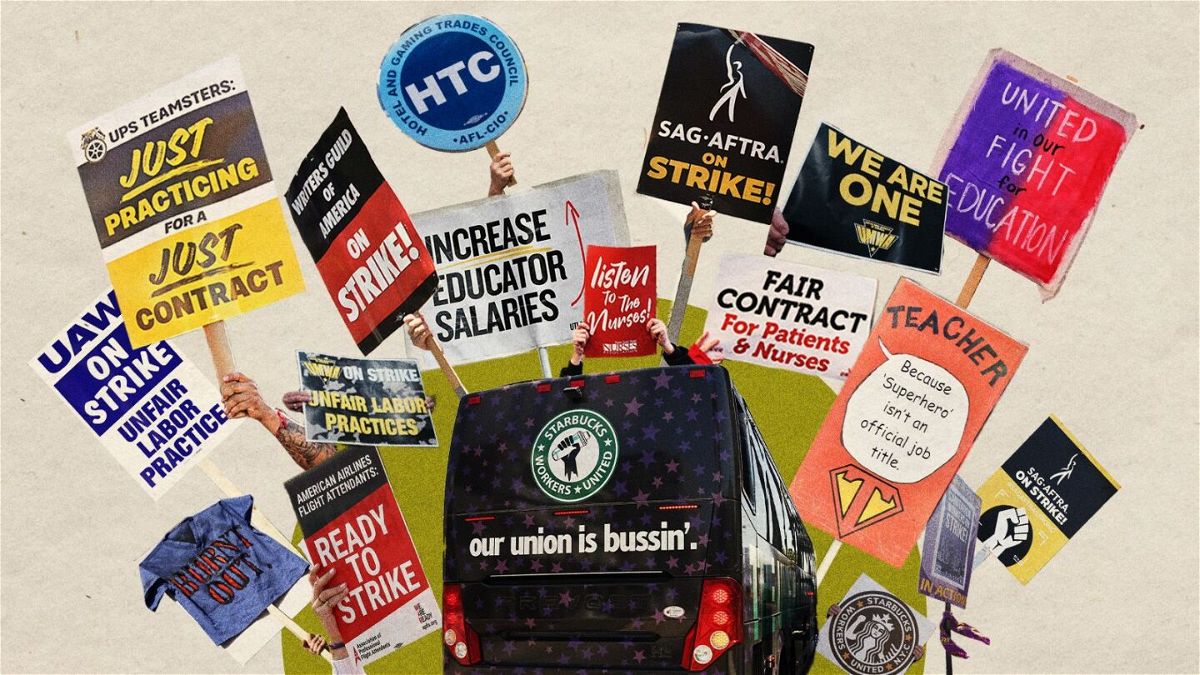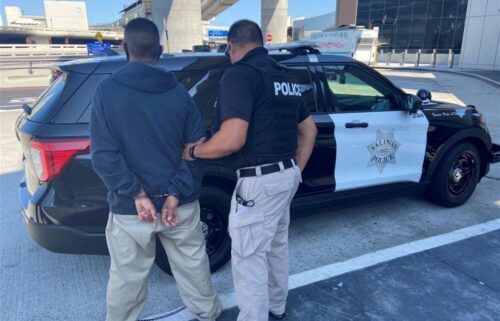US unions have flexed their muscle this past year. Are they winning?

Originally Published: 04 SEP 23 09:27 ET By Chris Isidore, CNN
New York (CNN) — Since last year’s Labor Day, US unions have flexed their muscle in a way not seen in decades. They’ve scored some big victories amid some defeats.
“It’s been a good year for unions,” said Art Wheaton, director of labor studies at Cornell University’s Industrial and Labor Relations school in Buffalo, New York. “You’ve seen a lot of successes and that will help going forward. I give them a B+. Not an A.”
The Teamsters union used the threat of a strike by 340,000 members at UPS to achieve most of its bargaining goals, including significantly improved wages for part-timers who make up most of the Teamster membership at the company.And thousands of UPS workers hired since 2018 to let UPS move to 6-day a week delivery had been receiving a lower tier of wages, and that lower pay tier was eliminated. Memberships voted overwhelmingly to approve the deal.
Increasing number of strikes
While the Teamsters avoided a walkout, the US labor movement has shown an increase in the number of major strikes. A strike tracker database from Cornell University shows that from September 1 of last year through August 31 of this year, unions initiated 70 strikes, with 100 or more workers participating for more than a week.
That’s far more than one significant strike a week, and it’s up 40% from the same period a year earlier.
Meanwhile, other smaller strikes include one-day strikes at Starbucks locations that voted to unionize but haven’t yet reached an initial contract. When including those smaller strikes, the total number of strikes in the past year increased to nearly 400.
Unions used strikes to win many of their bargaining goals over the last year, from non-teaching school workers in Los Angeles to nurses in New York City. But not all these strikes ended in success.
Nearly 1,000 coal miners in Alabama returned to work at Warrior Met Coal in March after being on strike nearly two years, one of the longest US strikes in recent years. The United Mine Workers union never reached a deal on a new contract.
Still, the unions have been enjoying success, helped by a near-decades low in unemployment and by employers posting more job openings than there are unemployed job seekers. That gives workers some leverage to demand more of what they want, whether it’s better pay and benefits or simply a better work-life balance.
Many of the health care workers unions say their main issue is lack of adequate staffing and the workers’ belief that they’re not able to provide the level of care they want without more help.
Not just wages at issue
The Biden administrationandCongressstepped into a labor disputelatelast year when freight railroad workers threatened to strike. Congress and Biden wanted to prevent damage to the US economy if the four major freight railroads shut down. But they took heat from the unions by voting to impose a contract that did not include sick days.
More than 100,000 freight railroad workers received immediate 14% raises, back pay and raises totaling 24% over the five-year life of the contract.But most voted against the deals, complaining about quality of life issues, particularly the lack of sick days. Many saw the outcome as a defeat for the rail unions.
But since that congressionally mandated contract took effect, the railroads reached separate agreements with the rail unions that gave most of those rail workers the sick days they sought.
Some union members struggling
Many unions’ members are struggling as they flex their muscle, most notably the roughly 160,000 actors who belong to SAG-AFTRA who have been on strike against major studios and streaming services since mid-July. Another 11,000 members of the Writers Guildhave also been on strike against the same employers since early May.
Observers see little end in sight for either of those strikes. While the unions halted production of shows and movies, the media and tech companies that would have paid for those productions are actually saving money from the lack of filming, which bolsters their recent cost-cutting efforts.
Generally, the public has sided with the union members in these disputes. A poll by Gallup released at the end of August showed Americans sympathize more with the television and film writers than with the television and film production studios, with 72% supporting the writers and 67% supporting the actors.
The public also sees unions having more power than in the past, and they approve of that, according to the poll. A record-high 61% believe unions help rather than hurt the US economy, topping the prior record set in a 1999 survey by six points. And the number of people who want unions to gain more power has risen steadily to 43% today, up from a record low positive response of only 25% to that question in a 2009 survey following the Great Recession.
“Labor unions are enjoying a moment of high public approval and strong belief in the benefits they offer to workers, businesses and the economy,” said a statement from Gallup’s release. “Today’s striking workers may have a stronger hand in their negotiations than they would have had in the past given today’s elevated public support for unions.”
That can raise the public relations risks for employers facing a strike.
More major strikes loom
A number of major labor disputes are still looming.
Most notably, the United Auto Workers union is threatening a strike or strikes by as many as 145,000 members against one or more of the three major unionized US automakers — General Motors; Ford; and Stellantis, which makes vehicles under the Jeep, Ram, Dodge and Chrysler brands.
The union which, according to the Gallup poll, has the support of 75% of Americans surveyed, laid out an ambitious set of goals at the bargaining table. Their demands include raises of 40% or more during the life of the contract,restoring thecost-of-living adjustments in pay to protect members from rising prices, and recapturing concessions made to the automakers earlier in the century when several automakers faced financial hurdles and as GM and Chrysler headed for bankruptcy and federal bailout.
So far, the two sides don’t appear close to reaching deals with a strike deadline set for 11:59pm on September 14.
Soon after that deadline, unions representing 85,000 health care workers, including nurses and other support staff, at Kaiser Permanente facilities in seven states nationwide are due to conclude their own strike authorization vote. A strike could start for those workers as soon as October 1.
The-CNN-Wire
™ & © 2023 Cable News Network, Inc., a Warner Bros. Discovery Company. All rights reserved.


